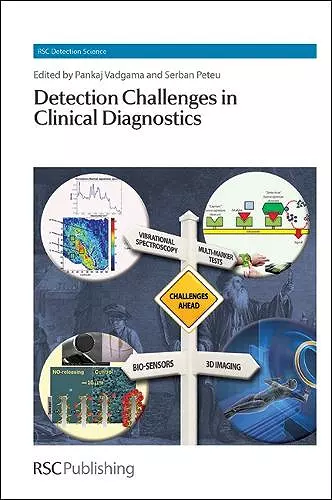Detection Challenges in Clinical Diagnostics
Pankaj Vadgama editor Serban Peteu editor
Format:Hardback
Publisher:Royal Society of Chemistry
Published:26th Sep '13
Currently unavailable, and unfortunately no date known when it will be back

There are many remaining challenges impeding future progress in field of Clinical Diagnostics. This book presents a technical assessment and vision of clinical leaders, scoping the clinical and other diagnostic needs and the bottle-necks in their cognate fields. Issues of real environmental biological measurements from the perspective of the end-user are presented and thus the book serves to inform the direction of the fundamental scientific efforts. Both editors are experienced practitioners within the biosensor technology and are involved first-hand with the healthcare and clinical applications of detection science.
Advances in clinical diagnostic devices are moving exponentially, and it is believed that this sector is only at the beginning of the curve. Star Trek fans will point to the medical 'Tricorder' as the ultimate end result of clinical diagnostic research, but will accept it is probably several centuries away from reality. In contrast, tens of millions of blood samples are routinely drawn daily to be followed by automated and highly efficient analysis to determine the origins, presence or incipient onset of potential illnesses. Most results are guides, rather than specific indicators, that include glucose, electrolytes, blood fats, thyroid function, kidney function, blood cell counts, PSA tests and other ELISA evaluations. Many researchers are currently evaluating the presence of cancer marker proteins with an ever increasing success rate. It is clear once a diagnostic method is clinically approved and automated it becomes a huge resource of relevant and valuable information to the medical profession. Without these data, medical practitioners cannot provide accurate diagnosis and ongoing treatment. Consequently, proven diagnostic devices are needed, in demand and willingly accepted by all parties. There is currently a large gap between technology in use and technology available. Biosensors and 'lab-on-a-chip' devices potentially offer rapid label-free measurement, but are sparsely represented in the current universally used routines employed in most hospitals. There is obviously a need to close this gap to the satisfaction of those that pay the health-care bills. The plethora of recent publications is simply a reflection of the activity in the field and part of the process of reporting another faster, more accurate, hopefully less expensive method to assist diagnosis. This is the second book in the RSC Detection Science Series, and has 28 contributors largely based in the UK but with major contributions from Canada and the USA. The book is divided into nine chapters, with the first two also considering the role that the patient has to play in the overall process. Dry reagent systems for glucose are dealt with in Chapter 3, and Chapter 4 covers electrochemical detection of disease-related diagnostic biomarkers. The advantages/ disadvantages and biocompatibility of in vivo sensors are explained in Chapter 5. Chapter 6 is intriguing. The role of nitrogen oxides in several biological cycles has been well established for many decades, recently evolving into detailed studies of reactive nitrogen and oxygen free radical species. The elusive peroxynitrite radical ONOO- (PON) is highlighted as a potent death cell inducer in several devastating diseases, suggesting early accurate detection would be an important addition to routine analysis. Chapter 7 involves how to classify risk in patients suffering from myelodysplastic syndromes (MDS), and Chapter 8 exemplifies a real-time probe analysis of oesophageal carcinoma. It is anticipated several more books will evolve in this series, each updating a specific target. For some time to come these can only be little more than a current commentary on the rapidity of change in this essential sector of the medical device industry. -- Ken Jones * Chromatographia (2015) 78:297-298 *
ISBN: 9781849736121
Dimensions: unknown
Weight: 547g
246 pages